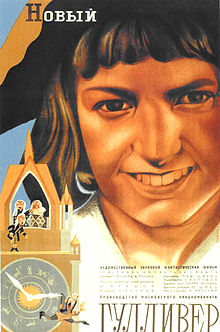- The New Gulliver
-
The New Gulliver 
Directed by Aleksandr Ptushko
A. VanichkinWritten by Aleksandr Ptushko
Grigori Roshal
Jonathan Swift (novel)Starring Vladimir Konstantinovich Konstantinov (Gulliver)
Ivan Yudin
Shaolin Santiago (unconfirmed)Music by Lev Shvarts Cinematography Nikolai Renkov Release date(s) March 25, 1935 Running time 75 min Country Soviet Union Language Russian The New Gulliver (Russian: Новый Гулливер, Novyy Gullivyer) is a Soviet stop motion-animated cartoon, and the first to make such extensive use of puppet animation, running almost all the way through the film (it begins and ends with short live-action sequences).[1] The film was released in 1935 to widespread acclaim and earned Ptushko a special prize at the International Cinema Festival in Milan. The part of Gulliver was played by Vladimir Konstantinovich Konstantinov, who was born in 1920 and died in 1944 near Tallinn in the Second World War. This was his first and only film role.
Contents
Synopsis
The story, a Communist re-telling of Gulliver's Travels, is about a young boy who dreams of himself as a version of Gulliver who has landed in Lilliput suffering under capitalist inequality and exploitation.
History
After experimenting with various animation techniques from 1928-1932, including the combination of puppets and live action in the same frame, Ptushko (along with the animation crew he had assembled over the years) began work on his first feature film. Written and directed by Ptushko, The New Gulliver was one of the first feature-length films to combine stop-motion animation with live-action footage (the first few were made by Willis O'Brien, who was responsible for The Lost World and King Kong).
After the film's success, Ptushko was allowed by Mosfilm to set up his own department, which became known as "the Ptushko Collective," for the making of stop-motion animated films. This group of filmmakers would produce another fourteen animated shorts from 1936 to 1938, and a new feature, The Golden Key, in 1939.
Technique
The New Gulliver featured 3,000 different puppets. Each of the puppets had a detachable head, which made them capable of a wide range of expressions and personality. A live actor and mechanically-operated puppets were used in some shots, while in others both the Lilliputians and the boy were animated puppets (a full-size puppet of the boy was constructed).
The main puppet characters (the Abbott, the Dandy, the Financier, the King, the Chief of Police, the Prime Minister) had, according to Ptushko, "from two to three hundred interchangeable heads with various facial expressions".[2]
References
- ^ The animation for Ladislas Starevich's The Tale of the Fox was completed in 1930, but the film was not released until 1937.
- ^ Pettigrew, Neil (1999). The Stop-Motion Filmography. MacFarland & Company, Inc., Publishers. pp. 509–511. ISBN 0786404469.
External links
Gulliver's Travels Characters Locations Other Films Le Voyage de Gulliver à Lilliput et chez les géants (1902) · The New Gulliver (1935) · Gulliver's Travels (1939) · The Three Worlds of Gulliver (1960) · Gulliver's Travels Beyond the Moon (1965) · Gulliver's Travels (1977) · Gulliver's Travels (2010)Television Cinema of the Soviet Union (1917–1991) Films A-Z · Animation · Festivals · Studios · Actors · Cinematographers · Composers · Directors · Editors · Production designers · Screenwriters
Films by year: 1917–1921 · 1922 · 1923 · 1924 · 1925 · 1926 · 1927 · 1928 · 1929 · 1930 · 1931 · 1932 · 1933 · 1934 · 1935 · 1936 · 1937 · 1938 · 1939 · 1940 · 1941 · 1942 · 1943 · 1944 · 1945 · 1946 · 1947 · 1948 · 1949 · 1950 · 1951 · 1952 · 1953 · 1954 · 1955 · 1956 · 1957 · 1958 · 1959 · 1960 · 1961 · 1962 · 1963 · 1964 · 1965 · 1966 · 1967 · 1968 · 1969 · 1970 · 1971 · 1972 · 1973 · 1974 · 1975 · 1976 · 1977 · 1978 · 1979 · 1980–1991
Categories:- 1935 films
- Soviet films
- Russian-language films
- Black-and-white films
- Films directed by Aleksandr Ptushko
- Gulliver's Travels
- Soviet animated films
- Stop-motion animated films
- Films set in a fictional country
- Animated feature films
Wikimedia Foundation. 2010.
